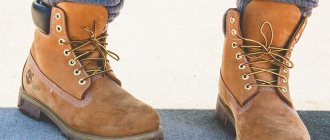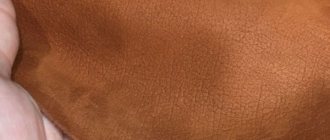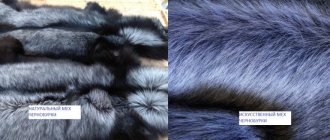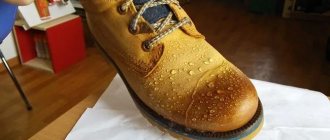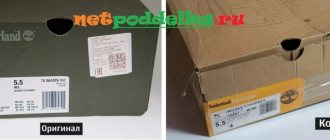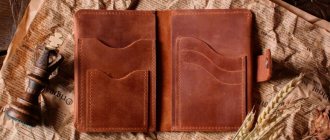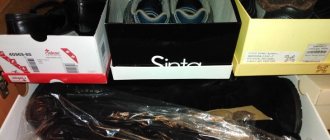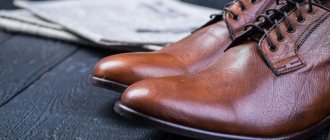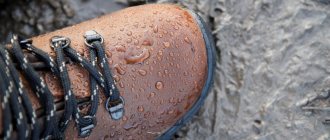What kind of material is nubuck for shoes? Read more in the article.
Nubuck – natural leather with fine pile. Shoes made from this material are very popular because they are not only strong and durable, but also have a presentable, expensive appearance.
Read an article on our website about how to paint shoes made of leather, suede or nubuck at home . It provides valuable tips and advice.
It is similar in many ways to suede, however, it also has its own characteristics that you need to know about if you want to purchase shoes made from this material. Read more in this article.
What is natural and artificial nubuck for shoes?
Natural nubuck
Nubuck for shoes can be natural or artificial. At first glance, there are no differences between them, because products made from them look equally chic. But this is the problem, since an uninformed person can easily be sold a leatherette product under the guise of shoes made of natural material. More details:
NATURAL NUBUCK:
- This is a material that is obtained by processing the skin of young cattle.
- It is characterized by high strength, beautiful appearance and good quality.
- It is used for upholstery of furniture, as well as in the production of shoes.
In the production of natural nubuck we use:
- Opoek . These are the skins of 6 month old (or younger) calves. The material is durable, but very soft, delicate and elastic.
- Outgrowth . It is taken from one-year-old calves. Its texture is coarser and denser, so it is not as elastic as opokek.
- Half-skinned . It is obtained from cattle older than 1 year .
To obtain the velvety material from which shoes are subsequently made, nubuck undergoes a thorough processing process. In particular, chrome tanning is performed using chromium salts. After this, the material becomes quite soft and elastic, so nubuck shoes do not hinder the movement of the legs.
ARTIFICIAL NUBUCK:
- It is a synthetic material that is obtained by spraying polymers onto each other.
- This manufacturing method allows you to obtain raw materials with fibers of the required length and diameter.
- Artificial nubuck has a longer shelf life.
- It tolerates mechanical stress and temperature changes well.
- In addition, shoes made from it are available in a wider range of colors.
Many people view products of this type with distrust. But, as you can see, it also has its advantages, moreover, it costs less than boots made of natural nubuck.
How to distinguish real nubuck from artificial?
Real natural nubuck
It is actually very simple to distinguish genuine leather from fake leather - artificial nubuck, and you can do this both at home and in the store. More details:
- Pay attention to the tag. If the shoes are natural, then the tag will be made of the same material. In addition, there will be a mark with an animal figure on it.
- Regarding shoes made from artificial nubuck, the tag in this case can be completely different - from paper, cardboard, cotton rag.
- The presence of synthetic material is indicated by a diamond.
Now about the test that you can do at home. Nubuck is distinguished by its ability to quickly absorb moisture, but its substitute, on the contrary, repels it. Therefore, moisten the surface of the product with water and observe. If the liquid is quickly absorbed, you have shoes made of genuine leather, but this feature is unusual for artificial raw materials, so it will not be difficult for you to recognize them.
What is the difference between nubuck and suede: which is better?
Nubuck
In fact, there are not very many differences between nubuck and suede. They even have similar principles of care and cleaning. The difference between these materials lies in the method of their preparation. What is the difference between nubuck and suede?
- If nubuck is the leather of cattle, then suede is obtained from the skins of smaller animals. In particular, deer.
- Consequently, it is somewhat more tender, and after tanning with fats and oils it becomes very soft.
What's better? What to choose?
- The first thing you need to consider is how and where you will wear your shoes.
- After all, nubuck gets dirty and wet very easily, unlike suede. This is a huge drawback of this material, although it also looks very attractive in appearance.
- But even in this case there are some nuances. For example, suede is more suitable for long-term wear than nubuck. It is more resistant to moisture and dirt, and is easier to clean.
Therefore, the choice is yours.
Material characteristics
Many “advisers” on the Internet confuse nubuck with suede, velor, genuine leather and even fabric. Let's conduct a short educational program on what nubuck is and how it differs from other materials, what types exist. Often people are looking for an answer to the question of whether it is leather or not.
There have long been several methods of tanning leather. This is done using fat, salt, extracts of certain types of trees (for example, oak), sand and other materials. The main difference between nubuck and suede is the material and tanning method. Suede is made from the skin of small cattle, and nubuck is used from large cattle (deer, elk, yaks). Tanning of suede is carried out using fat and fat-formaldehyde compounds. Nubuck is tanned with mineral salts, most often chrome.
Leather treated in this way is more pliable and wear-resistant. Shoes and furniture upholstery made of nubuck offer excellent resistance to stretching and impact loads.
But it must be remembered that both natural suede and natural nubuck are capricious materials. They are demanding of external conditions and require constant care.
The main advantage of natural nubuck is the aesthetic and tactile pleasure from contact with it. Lying down on a sofa upholstered in natural nubuck is like touching something soft and tender! And shoes made from it look great in any situation and with any style.
Where is it used?
This material has two directions:
- Furniture . Upholstered furniture fabric is used to cover designer furniture, creating surfaces of chairs, armchairs, sofas and beds that are pleasant to the touch and to the eye.
- Shoe. The material protects our feet from overheating, hypothermia, and moisture.
Nubuck is a very beautiful material for shoes, women's boots and designer shoes.
In footwear, natural oiled nubuck is more common, as it has water-repellent properties. A natural analogue is better suited for furniture production - it is more pleasant to the touch.
How to choose blankets 220x240?
Watch the video on how to put European covers on upholstered furniture.
Photo of memory cotton fabric: .
Nubuck or leather: which is better?
Nubuck
There is also no clear answer to the question of what is better - nubuck or smooth leather. Both types of material perfectly retain heat and are durable. Both leather and nubuck boots look impeccable, stylish and expensive.
- But the difference is that calfskin products can retain their original appearance for much longer. They are less susceptible to creases, of course, if you care for them properly.
- Leather boots, unlike nubuck ones, do not allow water to pass through. Therefore, they are perfect for wearing in wet weather. They are not negatively affected by precipitation or temperature changes.
This comparative description of both types of leather shoes will help you make the right choice. But if there is such an opportunity, it is better to purchase both pairs at once in order to have an alternative for any weather.
What are the differences
The differences between the materials are presented in the table.
| Index | Leather | Nubuck |
| Tolerance to various mechanical influences | Well tolerated | Doesn't tolerate well |
| How quickly it wears out | Has a long service life | Not durable |
| Required care | Easy care | Needs special care |
| Ability to absorb water | Does not allow water to pass through | Water-permeable (cannot be worn in rainy weather) |
| Is the product shiny? | Not shiny | Shiny (especially with frequent wear) |
| How quickly it loses its presentable appearance | Maintains an aesthetic appearance for a long time | Quickly loses its aesthetic appearance |
| Can properties be changed using various means? | Possible, but not essential | You can significantly change the properties of the product |
| Air permeability | Does not allow air to pass through | Allows air to pass through |
| Price | High | Lower than leather products, but not significantly |
Nubuck shoes: pros and cons
Nubuck shoes
Any shoe has its advantages and disadvantages, and nubuck products are no exception. Among the advantages of calfskin leather (nubuck) material are:
- Beautiful appearance: Nubuck is very similar to suede, looks elegant and sophisticated
- Pleasant tactile qualities
- Strength
- Good ventilation to prevent your feet from sweating
- Nubuck shoes are quite practical, presentable and attractive.
- You can safely wear it to a corporate event or business meeting.
Now about the disadvantages of the products. Among them:
- The need to purchase special nubuck care products
- Difficulty cleaning shoes
- Mandatory regular processing
- Rapid loss of shine due to improper or incomplete care
Nubuck products are fastidious in terms of care. However, if you do not neglect simple rules, your shoes will always look like new.
Does artificial or natural nubuck get wet?
Natural nubuck can get wet
Nubuck is a durable material, especially if it is natural. But, alas, it is not without its shortcomings. Shoes made from this leather tend to allow water to pass through. And although this takes a lot of time, wearing nubuck boots for a long time in conditions of high humidity outside leads to the product getting wet.
Worth knowing: If you do not completely dry a wet natural nubuck product, creases will begin to appear on its surface. Therefore, always use newsprint or a special device to dry your boots from the inside.
As for artificial nubuck, it is more durable and hardy. Because its surface is harder than natural material, it repels water much more effectively. Therefore, there is less fear of such a product getting wet.
If your shoes do get wet, then read the article on our website about how to quickly dry boots made of leather, suede or nubuck .
However, in both cases, other nuances are possible:
- It is important to monitor the integrity of the soles of your boots, as they can peel off over time.
- Water “enters” faster into the resulting cracks.
- Therefore, your feet may also be wet after wearing shoes.
To avoid this, experts recommend taking special preventative measures. It is carried out in specialized shoe repair shops. In addition, preventive measures add durability to shoes and reduce their wear, so it is advisable not to spare money on their implementation. It costs much less than buying new leather boots. Good luck!
Prices
Nubuck belongs to the premium class of upholstery and shoe materials. Its price is slightly lower than for suede, but higher than for our usual leather without surface treatment.
Natural material can be purchased in specialized stores at a price of 0.7 dollars per 1 square inch. Naturally, the price rises when animals such as yak and elk are taken for its production, and also subjected to fine processing of the front surface.
Synthetic or artificial nubuck for carpets, upholstery and other needs can cost $3-5 per square meter. Depending on the number of layers of polymers, their thickness and structure. Usually it goes in the “Fabrics” and “Artificial Leather” sections.
Nubuck is aesthetics and beauty. It is used to upholster Italian furniture; thanks to it, the surfaces of armchairs and sofas become pleasant to the touch. Of course, there is a huge difference between natural and synthetic material.
Natural is more suitable for the bedroom. It cannot be cleaned and washed very often; it absorbs moisture and is afraid of strong mechanical influences. But its appearance evokes only pleasant thoughts; you immediately want to touch it, lie down on its surface. The tactile sensations when touching it are almost the same as when touching suede.
Artificial is more practical and common. It can be found in car showrooms, on the floors of children's rooms, in living rooms and kitchens. Its water-repellent properties allow this material to be washed and cleaned a considerable number of times. Also read the characteristics of Cordura furniture fabric here.
